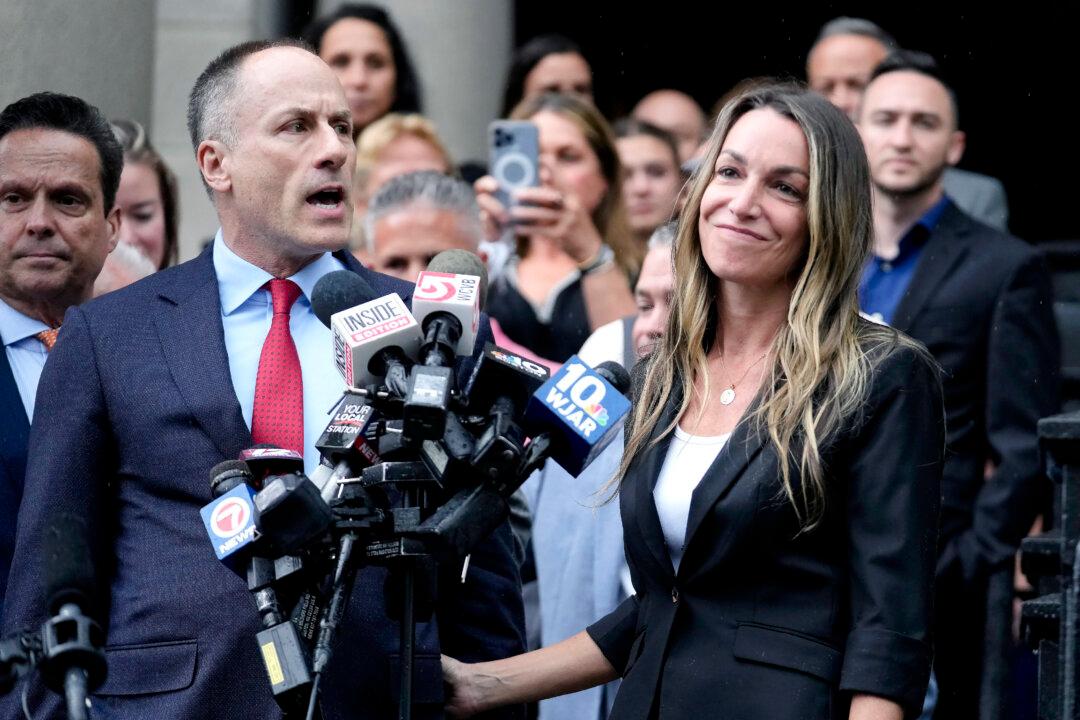People for The Ethical Treatment of Animals (PETA) has received a lot of criticism for promoting veganism and leather alternatives, but in the past two weeks, the international animal rights organization has braved bombs and gunfire to help puppies, dogs, cats, and kittens that have been left homeless in the wake of Russia’s invasion of Ukraine.
Petya Petrova, PETA’s campaign coordinator for Eastern Europe, initially spoke to The Epoch Times on March 2 while riding in a van with other animal rescuers traveling to Lviv, Ukraine, and other surrounding towns to pick up stray and abandoned animals, as well as pets and their owners, and drive them back to the border.
Petrova is specifically working with Viva!, an animal sanctuary located just outside of Warsaw, Poland, while other PETA field operators have teamed up with shelters in other border countries.
“I’m very determined to go,” said Petrova, a native of Bulgaria. “Animals do not think in terms of borders. They are terrified, hungry, and confused and just want the noise and chaos to stop.”

A Ukrainian refugee holds her pet cat as she and others arrive by bus at the Greek–Bulgarian border at Promachonas, Greece, on March 7, 2022. Sakis Mitrolidis/AFP via Getty Images
On March 4, after waiting for 12 hours at the Poland border with a van full of dogs and cats, Petrova spoke again with The Epoch Times, confirming that she had made it back safely. On March 6, she said she was readying for another trip into Ukraine.
Petrova is one of the luckier rescuers trying to reach the most helpless of the victims of Russia’s attack on Ukraine, which also includes zoo animals still trapped in cages. At least six animal rescuers have reportedly been killed just this week as they were working to help some of the thousands of Ukrainian animals caught in the violence of the war, according to Petrova and various media outlet reports.
Three of the volunteers were reportedly shot to death in their car on March 5 as they were returning from the town of Bucha, Ukraine, where they had delivered food to a dog shelter.
The shelter, which is just 18 miles outside of Kyiv, Ukraine, had been without food for three days. One of the shooting victims was 26-year old Anastasiia Yalanskaya, whose husband told Canada-based Global News that she was close to home when the car she was traveling in came under heavy gunfire.
Border countries to Ukraine, including the Czech Republic, Hungary, Lithuania, Romania, Poland, and Slovakia, have agreed to permit entry of the Ukrainian animals without documentation, according to PETA.
Bulgaria is also taking the Ukraine animals without documentation under an emergency agreement with PETA. But with an already high stray population before the Russian invasion of Ukraine, the border and outlying countries are only temporary havens for Ukrainian animals.
Petrova told The Epoch Times that the ultimate goal is to get the animals to western Europe. But unlike the central European countries, the UK, Italy, and others are requiring documentation and quarantining, which has thwarted efforts by animal rescue groups to help the Ukrainian animals.
The UK’s refusal to lift its steep custom tariffs has especially drawn ire from animal advocates there.
“I am sickened that in this moment of serious conflict we can not just be waved through and get this aid to where it is needed,” Jason Yorke, who runs a small dog rescue group in England, posted on Facebook.

A woman carries a pet rabbit as she exits a train arriving from Kyiv, Ukraine, at Przemysl main train station in Poland on Feb. 23, 2022. Omar Marques/Getty Images
Yorke said that while the UK has a special code for “humanitarian aid,” it doesn’t classify pet food under the category.
He’s a volunteer with Dogbus, a UK-based animal transportation and rescue organization.
It operates a rescue shelter in Bucharest, Romania, but that shelter is already at capacity and has been told by the UK government that it has to wait weeks before bringing animals from Ukraine to its UK shelter.
“It is frustrating,” Petrova told The Epoch Times.
She said a league of veterinarians remain at the border, working around the clock checking rescued animals. None of them have shown any sign of disease, only injuries sustained in the fighting, malnutrition, and dehydration.
Before the arrival of PETA and other organizations, individual animal rescuers had taken to social media asking for food and water for the animals and posting pictures of them huddling in makeshift shelters.
As many evacuated Kyiv, Andrea Cisternino, well-known among locals for his animal rescue work, stayed behind to care for his rescues—posting last week on his Facebook page about his challenges to keep the animals calm during early morning bombings, artillery barrages, and aircraft flying overhead.
“We live with anxiety, but we try to be positive,” he said.
For the past 13 years, Cisternino, a photographer and native of Italy, has been running an animal sanctuary for more than 400 animals. They include domestic pets, as well as goats, chickens, and sheep. As of March 6, Cisternino said all of the animals were still alive and “managing.”
While many Ukrainians took their animals with them when they fled, many were left behind. Some operators of animal shelters also left without making any provisions for the strays they were housing, leaving a few volunteers who stayed behind to step in to do what they could for the animals abandoned at the shelters, according to Cisternino. Horses and large animals were largely abandoned.
Petrova said many pet owners fleeing Ukraine don’t have cars and have walked for miles to get their pets out of the country.
Satabdi Sharma told The Epoch Times that she walked 36 miles to the border with her tiger cat Crimsee under her jacket.
“I collapsed at the border, where people fed me while people took turns holding Crimsee for me,” she said.
Other animals weren’t as lucky. Several dogs died from exhaustion as they walked long distances to the border with their owners, according to Petrova. Others died from acute stress caused by loud explosions from bombs and missiles being dropped around them.
On the same day that Petrova was traveling from Germany to Ukraine, a Berlin resident voluntarily drove 20,000 tons of pet food into Ukraine. Many animal rescue shelters in border countries are helping, including Casa lui Patrocle in Romania, which has dispatched animal ambulances to the border to help pet owners and animals “no matter their species.”
Animal rescuers across the globe say they wish they could go to Ukraine and help the animals and people there.
One of them is Mohammed Aljaleel, an ambulance driver in Aleppo, Syria, who inspired the pictorial book “The Cat Man of Aleppo” by feeding hundreds of cats and dogs who became strays during the Syrian War.
Aljaleel, who now runs a cat sanctuary in Syria, told The Epoch Times that he’s worried that Ukrainians will end up suffering through an endless war like Syrians have and that the victims will be the same as they are in his country.
“War is the word that causes us pain,” Aljaleel said. “It causes great harm to children and pets and the elderly.”
And to animal rescuers.
Yalanskaya’s final Instagram post, made just hours before she was killed, is a picture of herself smiling while sitting next to the bags of dog food she was delivering.
Donations can be made here to help PETA in its efforts in Ukraine. The following organizations are also legitimate organizations helping the animals in Ukraine in need of donations: Casa lui Patrocle, Dogbus, and International Fund for Animal Welfare.




